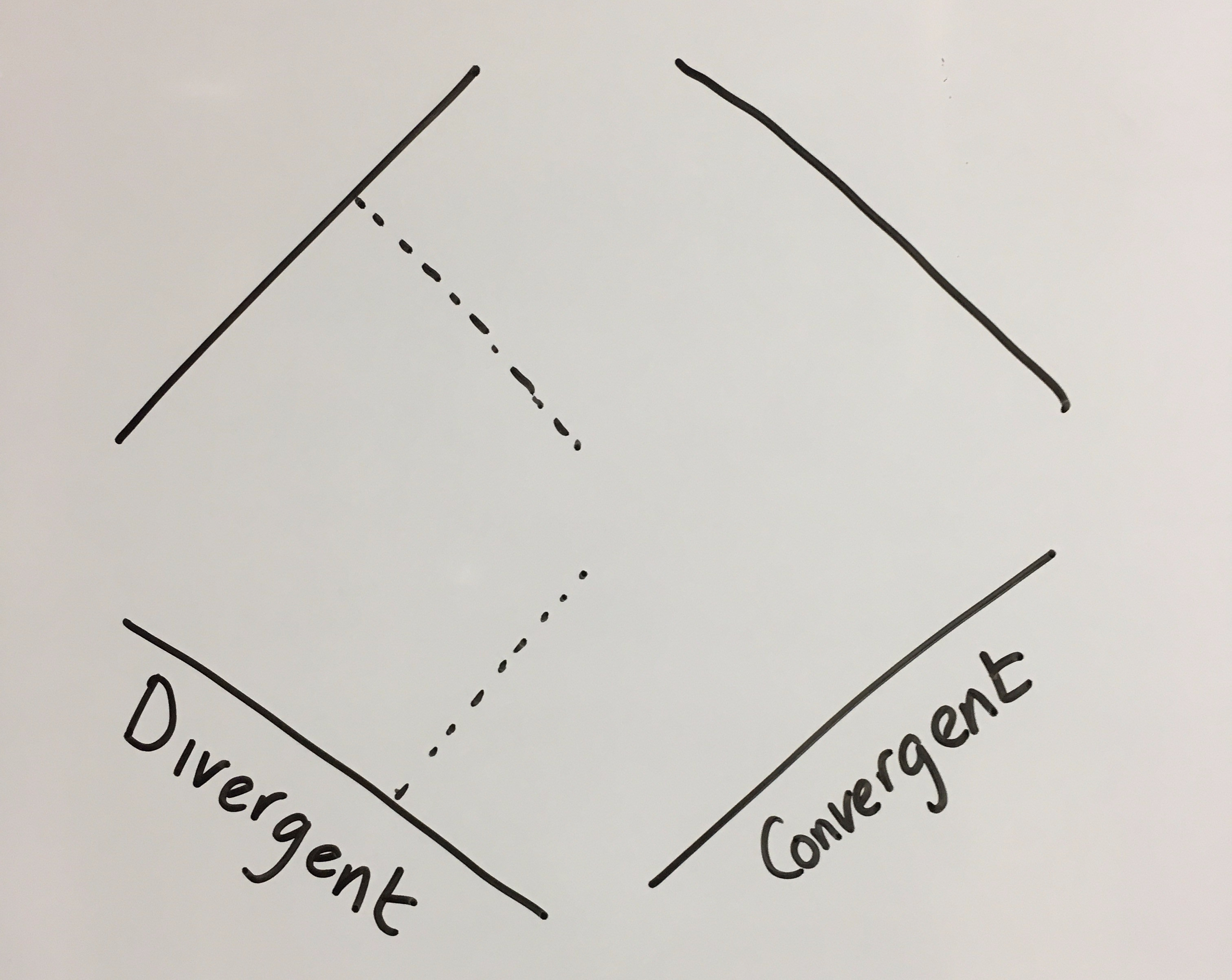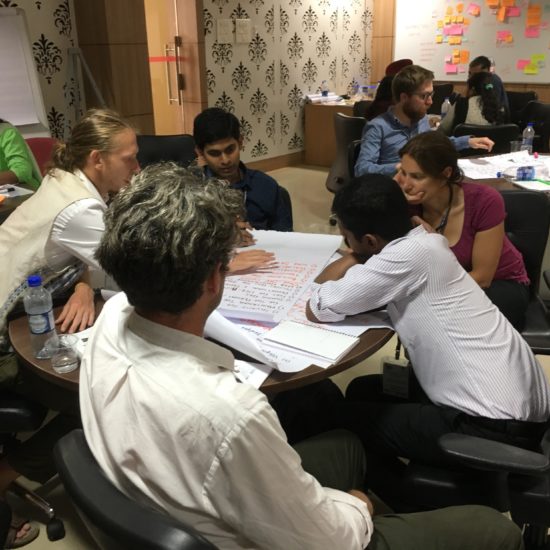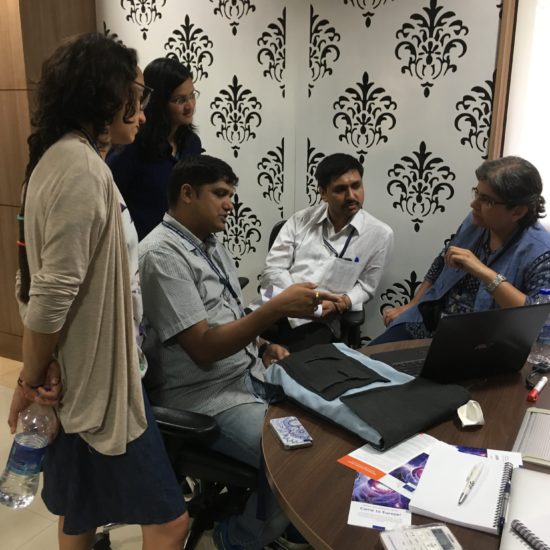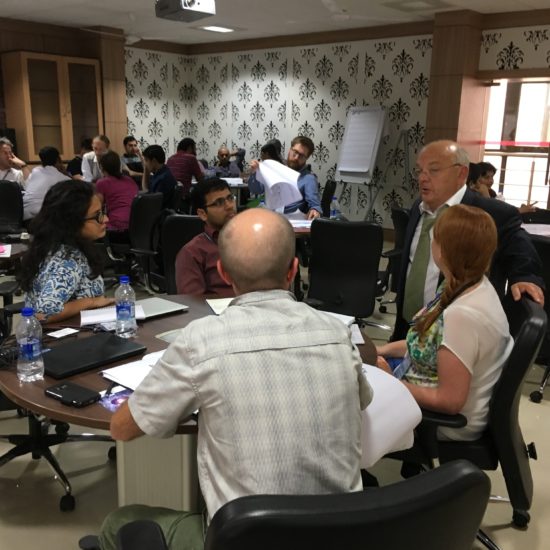Our Newton Bhabha Fund workshop (remember, we’re tweeting about the workshop using #CERRI) was carefully planned with the challenges of international development in mind. We began with a trip to rural villages, spent a day debriefing the visit and ensuring everyone understood the ethos of this type of funding. On the third day, when we stimulated idea generation, we spent the morning listening to people who had a wealth of experience linked to our theme of clean energy and rural India. Then it was time to see what this had prompted from our group.
The night before we did an initial “brain dump” in mixed groups so that people could share initial ideas and I encouraged them to be as creative and open as possible. In planning the workshop, we had in mind a framework for the week. At first we would broaden the perspectives of the participants through the visits and early discussions. In the second half of the week we would try to guide them to find a focus and begin to develop some project ideas. (This is explained as part of an interesting blog on Design Thinking and Social Innovation from Elon University.) When I explained the idea to the workshop PI, I added in an area at the point when you switch from Divergent to Convergent thinking – the “Groan Zone”.

I happily introduced this model and told everyone that we expected them to be uncomfortable and that it was fine and all part of the process. We then asked them to start thinking about what their initial ideas were and asked them to put them onto post-it notes so we could find clusters and overlaps.
The ideas flowed – we quickly filled the wall with possibilities. We merrily grouped them into themes and then stood back. People began to cluster and started to develop their ideas into project outlines with enthusiasm. And all the organisers and guest watched with discomfort, as we realised that despite the exposure to the village environment and a morning of hearing from experts, the group had instantly fallen back into their comfort zone. The projects that were emerging were solution led. The board of ideas was polarised into science problems and social science problems. One of the participants noticed this and everyone agreed that it wasn’t why we were here, but people hesitated to move.
A couple of our speakers intervened and said that the research had to start with the need. They stressed that the need was usually caused by complex, overlapping issues which weren’t respecters of disciplines. They urged the group to go back and start with the need of the villagers and communities.
To help, Neil quickly drafted a set of questions:
- WHAT IS THE NEED?
- Who are you helping?
- What is your impact?
- How will you do this?
- How will you communicate and engage people in your project?
Everyone went back to their ideas. Slowly, and with some inital difficulty, the need became the priority. The projects were set to one side as the group used the expertise of the guests and the personal experience of village life in the room to deepen their understanding of the need. We nudged one or two groups to take a look at their constituents – we’d noticed that one was devoid of social scientists and another had only one physical scientist. In one of my favourite moments of the workshop so far, a social scientist was “kidnapped” by one group who needed her skills and perspectives. We finished the day with a quick overview of each project and suddenly we started to get excited about what was emerging. Clearly these ideas have the potential to grow in proposals so I won’t share details here but they are now strongly aligned with the principles driving GCRF.
I wanted to write the post about our “near-miss” because there is so little information about the workshop running process that it can be easy to think that they all run like clockwork. We are spoilt here by having someone (me!) who’s only focus is the workshop facilitation and it was still challenging to work out how to intervene and to understand what had caused the slight deviation from the path we’d tried to set up.

I think what happened is that the complexity of the rural environment is such that we all felt a little overwhlemed by the scale of the challenge. Faced with so many unknowns, people retreated a little from the “groan zone” into the comfort of their expertise and disciplines.
 The problem with this is that the really beautiful ideas were past this point. We pushed the group out of their comfort zones and better ideas emerged. I’ll be honest about how surprised I was that this didn’t happen naturally, but it’s important to share this to give future workshop leaders an insight so they can look out for the same moment with their groups.
The problem with this is that the really beautiful ideas were past this point. We pushed the group out of their comfort zones and better ideas emerged. I’ll be honest about how surprised I was that this didn’t happen naturally, but it’s important to share this to give future workshop leaders an insight so they can look out for the same moment with their groups.
Some advice is to “shine a light” onto the idea generation and development process regularly in the early stages. We had three separate whole group idea sharing slots so we picked up on the limitations of the early projects quickly. We got everyone to put all their ideas onto the wall (using post-its) so the clustering of ideas around disciplines was immediately evident. Neil and the guest experts kept sitting in with the groups whilst the ideas were forming to challenge and guide them. Without these interventions it would have been difficult to spot the issues.
Overnight, the ideas have developed and new ones have emerged. There are now six ideas in development and they are all truly needs-led so the principles of ODA-compliance are embedded from the start. (In the next post I’ll talk a little about the ODA compliance that we discussed as well as sharing some of the resources we’ve found to fund the network and ideas in future.)
Today the group are expanding on their ideas and we’ve given them some new questions for guidance:
- CHECK YOUR PROJECT VISION FOR ODA COMPLIANCE
- What are the gaps in the idea/stakeholders or team’s skills base?
- What are your first steps?
- Who needs to be involved?
- What resources will you need?
- What else is happening in this space? (Do an initial literature search)
Tomorrow is our final day. The focus will be on building ownership of potential projects so everyone leaves with a clear plan and we’ll also think about the best strategies for maintaining the network. And I may cry a little as this has been a very special experience.




